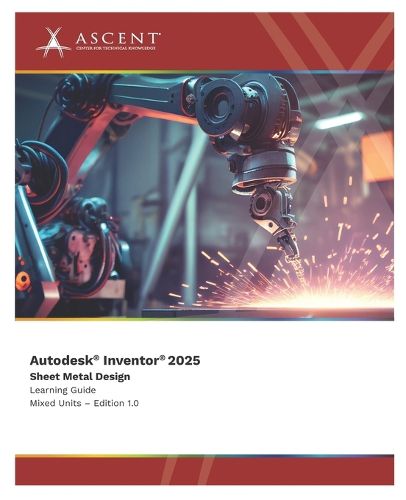Readings Newsletter
Become a Readings Member to make your shopping experience even easier.
Sign in or sign up for free!
You’re not far away from qualifying for FREE standard shipping within Australia
You’ve qualified for FREE standard shipping within Australia
The cart is loading…






Please note: The print version of this guide is printed in black and white with images in grayscale.
The Autodesk(R) Inventor(R) 2025: Sheet Metal Design guide introduces the concepts and techniques of sheet metal modeling with the Autodesk Inventor software.
The structure of the guide follows the typical stages of using the Autodesk Inventor software. That is, to create and edit sheet metal parts, generate flat patterns, and document the designs in drawings.
Topics Covered
Understanding the Autodesk Inventor Sheet Metal interface and workflow Creating base faces, contour flanges, and contour rolls Creating secondary faces, contour flanges, and contour rolls Working with sheet metal parameters Creating flanges Adding hems, folds, and bends to sheet metal models Adding corner rounds and chamfers to sheet metal models Removing geometry from a sheet metal model (holes, cuts, and punch features) Controlling sheet metal geometry using corner seams (seams and miters) Generating flat patterns Creating lofted flanges Creating rip features to permit the flattening of the sheet metal geometry Unfolding and refolding sheet metal geometry Designing multi-body sheet metal models Documenting and annotating sheet metal drawings Converting solid models to sheet metal models Working with sheet metal styles
Prerequisites
Access to the 2025.0 version of the software, to ensure compatibility with this guide. Future software updates that are released by Autodesk may include changes that are not reflected in this guide. The practices and files included with this guide are not compatible with prior versions (e.g., 2024). The material covered in this training guide assumes a mastery of Autodesk Inventor basics as taught in Autodesk Inventor: Introduction to Solid Modeling. Knowledge of sheet metal processing is an asset, but not required.
$9.00 standard shipping within Australia
FREE standard shipping within Australia for orders over $100.00
Express & International shipping calculated at checkout
Stock availability can be subject to change without notice. We recommend calling the shop or contacting our online team to check availability of low stock items. Please see our Shopping Online page for more details.
Please note: The print version of this guide is printed in black and white with images in grayscale.
The Autodesk(R) Inventor(R) 2025: Sheet Metal Design guide introduces the concepts and techniques of sheet metal modeling with the Autodesk Inventor software.
The structure of the guide follows the typical stages of using the Autodesk Inventor software. That is, to create and edit sheet metal parts, generate flat patterns, and document the designs in drawings.
Topics Covered
Understanding the Autodesk Inventor Sheet Metal interface and workflow Creating base faces, contour flanges, and contour rolls Creating secondary faces, contour flanges, and contour rolls Working with sheet metal parameters Creating flanges Adding hems, folds, and bends to sheet metal models Adding corner rounds and chamfers to sheet metal models Removing geometry from a sheet metal model (holes, cuts, and punch features) Controlling sheet metal geometry using corner seams (seams and miters) Generating flat patterns Creating lofted flanges Creating rip features to permit the flattening of the sheet metal geometry Unfolding and refolding sheet metal geometry Designing multi-body sheet metal models Documenting and annotating sheet metal drawings Converting solid models to sheet metal models Working with sheet metal styles
Prerequisites
Access to the 2025.0 version of the software, to ensure compatibility with this guide. Future software updates that are released by Autodesk may include changes that are not reflected in this guide. The practices and files included with this guide are not compatible with prior versions (e.g., 2024). The material covered in this training guide assumes a mastery of Autodesk Inventor basics as taught in Autodesk Inventor: Introduction to Solid Modeling. Knowledge of sheet metal processing is an asset, but not required.